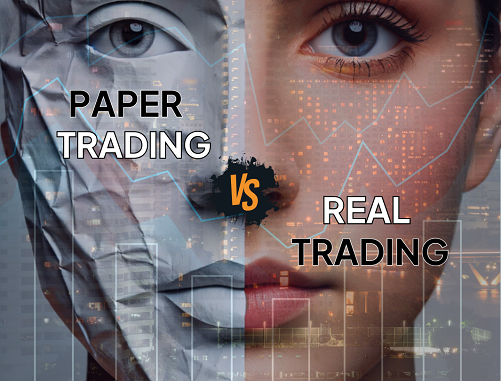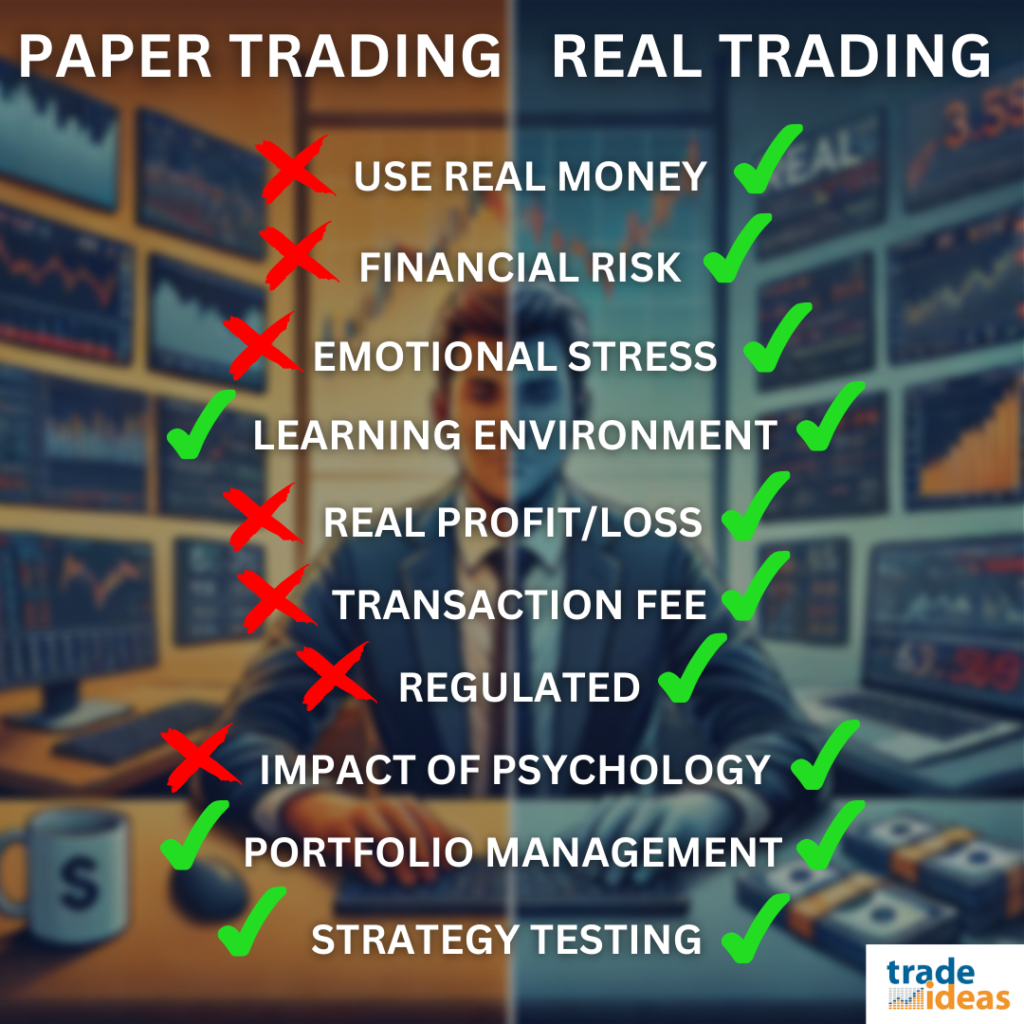
The Psychology of Paper Trading vs. Real Trading By Trade Ideas
Have you ever dreamt of making huge profits in the real market? If yes, then it’s essential to understand the world of trading can be both thrilling and competitive. The psychology of a trader plays a crucial role in achieving success.
While paper trading offers a safe space to experiment and backtest your strategies, real money introduces a whole new set of emotional challenges causing you to lose trades. Whether dipping your toes into paper trading or preparing to surf in the real water of live markets, mastering your emotions will equip you to understand yourself as a trader.
Buckle up as we explore the psychological battleground between paper trading and real trading, uncovering how emotions like fear, greed, and overconfidence can impact your decisions.
Overview of Paper Trading
What is Paper Trading?
Paper trading or virtual trading without using real money. It is helpful to practice and refine your trading strategies and analyze your trade’s risk ratio and profitability.
Why Use Paper Trading?
There are several reasons for someone to choose paper trading. Some of the reasons are:
- Practice Trading: To guide new traders in placing trades and identifying key aspects of trading.
- Testing the strategy: It is helpful to test and analyze the strategy and measure the success percentage.
- Identify Market Movement: To capture the market movement and identify the type of trading according to the period of holding the trades.
Psychological Aspects of Paper Trading
Both positive and negative psychological factors in paper trading could potentially benefit you when you move to real trading. Major psychological aspects of paper trading are:
- Lack of Emotional Involvement: Since there is no real money in paper trading, traders feel less emotional stress through which they might place random trades without proper strategy.
- Overconfidence: Success in paper trading can lead to overconfidence, which affects the learning process of trading.
- Forecasting Knowledge: Continuous learning and analysis with paper trading can significantly enhance your ability to of predict future market movements.
Pro Tip: Journaling your daily trades and reviewing your fear and greed helps manage your emotions.
Overview of Real Trading
What is Real Trading?
Real Trading is for placing trades with real money in a live trading environment. Here, the outcomes of the trade are based on live market movements. With real market conditions, there are real problems where a small mistake could wash out your capital.
Why Real Trading?
Once a person is confident that he is equipped with the necessary elements of trading, he starts his journey with real money. The reasons for someone to choose real trading are:
- To Gain Profits: Once the trader is ready to enter the market, he aims to gain potential profits by placing trades and predicting the market movement.
- Live Market Experience: Live trading helps you to understand and learn from your mistakes, guiding you to develop your skills and knowledge.
- Utilize Opportunities: Responding to big changes in market conditions allows you to take advantage of opportunities and implement your strategies.
Psychological Aspects of Real Trading
Unlike paper trading, real trading involves real money, which can affect a trader’s psychology and lead to poor decision-making. Real trading encompasses various aspects, including the following major elements:
- Fear and Greed: These are the two dominant emotions in trading. Fear involves the anxiety of losing money and missing opportunities, while greed can drive reckless and impulsive decisions.
- Cognitive Biases: Real trading often triggers various cognitive biases, such as confirmation bias and loss aversion which confuses when to place a trade.
Key Differences Between Paper Trading and Real Trading
The major difference between paper trading and real trading in the psychological and result-oriented aspects has many variations. Both types include both mental and capital investment in trading. Here are some key takeaways:
Emotional Stakes
- Paper Trading: Lower emotional investment due to the absence of real capital can lead to more objective decision-making. However, it might also result in careless and random trades, potentially causing overconfidence.
- Real Trading: High emotional stakes with real money involved, leading to stress, anxiety, and emotional decisions influenced by fear and greed.
Risk Perception and Management
- Paper Trading: No real financial risk leads to a less serious approach to risk management, often resulting in higher risk-taking and ignoring risk strategies.
- Real Trading: Every decision has real financial consequences, making risk management techniques essential. Traders should plan and stick to risk management strategies to protect their capital.
Decision-Making Process
- Paper Trading: Lower emotional stakes could end in more random trades and experimentation with different strategies without financial loss.
- Real Trading: Decisions are often influenced by emotions like fear and greed, with pressure to perform potentially leading to confusion and poor judgment.
Learning Progress
- Paper Trading: Provides a risk-free environment to learn and refine strategies but lacks the full reality of market pressures.
- Real Trading: Offers the most authentic learning experience with real financial consequences, providing valuable lessons and live results.
Bridging the Gap: From Paper Trading to Real Trading
Strategies to Mitigate Psychological Impact
- Gradual Transition: Start with a small capital and gradually increase the deposits by analyzing the psychological pressures and risks of real trading.
- Risk Management: Implement strict risk management techniques by setting stop loss to avoid huge losses and reduce stress.
- Emotional Regulation: Practice mindfulness and other stress-reduction techniques to maintain emotional balance.
- Consistent Review: Regularly review trades to understand emotional triggers and develop strategies to manage them.
Developing a Realistic Mindset
- Accept Losses: Understand that losses are a part of trading and develop a mindset that views them as learning opportunities.
- Stay Informed: Continuously educate yourself about market trends and psychological biases to stay informed and prepared.
- Seek Support: Engage with trading communities and find a good mentor to gain different knowledge and support.
Final Words
Paper trading is a great training ground, but real trading demands real discipline. Grasp the psychology of both to seamlessly transition your trading journey to be successful in the market.
Mastering your psychology and implementing the perfect strategy without FOMO and greed will surely result in good trades. Remember emotions are the enemy whereas discipline is the key to becoming profitable.
So, always remember to stick to your rules and place your trade wisely. Happy Trading!!!
FAQs
- Is trading based on psychology?
Yes, trading is greatly influenced by psychology. Traders’ emotions, such as fear and greed, can impact their decision-making processes, leading to wrong decisions.
- Do we get real money from paper trading?
No, paper trading does not involve real money. It is a simulated trading environment where individuals can buy and sell trade orders without risking actual capital.
- What are the negatives of paper trading?
Paper trading lacks emotional impact, accurate execution, and market influence, leading to overconfidence, unrealistic expectations, over-optimized strategies, and false security, which can result in poor execution in real trading.


